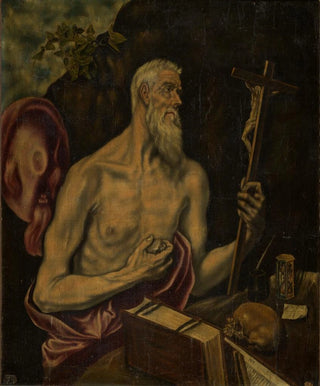Art print | Saint Jerome in Penitence - El Greco


View from behind

Frame (optional)
In the fascinating world of art, some works transcend their era to become timeless symbols of spiritual quest and human condition. "Saint Jerome in Penitence" by El Greco is one of those major pieces that captivate and provoke thought. This painting, imbued with profound spirituality, immerses us in the intimacy of a saint engaged in reflection and suffering. The depiction of Jerome, an emblematic figure of Christianity, evokes an inner struggle that still resonates today, offering viewers an invitation to explore the depths of their own consciousness. The work is not merely a simple portrait; it is a true emotional journey, a contemplation of faith and doubt.
Style and uniqueness of the work
El Greco's style, characterized by unparalleled expressiveness, is fully manifested in "Saint Jerome in Penitence." The vibrant colors and elongated forms of the figures demonstrate a technical mastery that transcends the conventions of his time. The painter plays with light and shadow to emphasize the features of Jerome’s face, revealing a rare emotional depth. The drapery, with its almost mystical fluidity, envelops the saint with a delicacy that highlights his vulnerability. Furthermore, the composition, though simple, is of great power. The saint’s gaze, lost in contemplation, seems to question us, pushing us to reflect on our own spiritual journey. This work is a fusion of the sacred and the human, a dialogue between the artist and his subject that invites silent meditation.
The artist and his influence
Born in Crete and having spent most of his life in Spain, El Greco managed to leave a mark on art history with his unique style and innovative vision. His ability to combine Byzantine and Western influences gave rise to a new aesthetic, where emotion takes precedence over realistic representation. "Saint Jerome in Penitence" fits within this lineage, demonstrating his interest in religious and psychological themes. The artist was able to capture the complexity of the human soul, influencing not only his contemporaries but also

Matte finish

View from behind

Frame (optional)
In the fascinating world of art, some works transcend their era to become timeless symbols of spiritual quest and human condition. "Saint Jerome in Penitence" by El Greco is one of those major pieces that captivate and provoke thought. This painting, imbued with profound spirituality, immerses us in the intimacy of a saint engaged in reflection and suffering. The depiction of Jerome, an emblematic figure of Christianity, evokes an inner struggle that still resonates today, offering viewers an invitation to explore the depths of their own consciousness. The work is not merely a simple portrait; it is a true emotional journey, a contemplation of faith and doubt.
Style and uniqueness of the work
El Greco's style, characterized by unparalleled expressiveness, is fully manifested in "Saint Jerome in Penitence." The vibrant colors and elongated forms of the figures demonstrate a technical mastery that transcends the conventions of his time. The painter plays with light and shadow to emphasize the features of Jerome’s face, revealing a rare emotional depth. The drapery, with its almost mystical fluidity, envelops the saint with a delicacy that highlights his vulnerability. Furthermore, the composition, though simple, is of great power. The saint’s gaze, lost in contemplation, seems to question us, pushing us to reflect on our own spiritual journey. This work is a fusion of the sacred and the human, a dialogue between the artist and his subject that invites silent meditation.
The artist and his influence
Born in Crete and having spent most of his life in Spain, El Greco managed to leave a mark on art history with his unique style and innovative vision. His ability to combine Byzantine and Western influences gave rise to a new aesthetic, where emotion takes precedence over realistic representation. "Saint Jerome in Penitence" fits within this lineage, demonstrating his interest in religious and psychological themes. The artist was able to capture the complexity of the human soul, influencing not only his contemporaries but also






